Above: The bread-grass roof has to be arranged layer by layer, from bottom to the top. Not one to skimp on details, Andoulan made sure even the bottom-most layer of bread-grass, which is not visible, is also trimmed neat and tidy.
While modern building materials such as sheet metal and concrete are gradually replacing traditional stone slabs and bamboo in communities, 64-year-old Pinuyumayan artist Andoulan chose to spend eight years to painstakingly build a detailed mini version of a traditional family house and a Takuvakuvan. These two miniature buildings will be submitted to the Pulima Art Award and Taiwan Craft Competition this year.
If you ever visit Andoulan's home, before seeing any miniature houses, you will first be welcomed by the fragrant scent of bamboo and beard-grass. Prior to making these two miniature houses, Andoulan had never made any models, nor had any training in handicrafts. But now when he is working on his models, he talks with such enthusiasm his eyes light up. “I have never been so passionate about anything in my life!” Andoulan exclaimed with a laugh.
Miniature Houses
that Represent the Traditional Community Lifestyle
The key incident that dramatically transformed Andoulan from someone with zero experience to expert of miniature houses was a bet in 2012. Back then Andoulan was working as a driver for the Taiwan Indigenous TV interview bus. Chief Director Masao Aki played some music by indigenous singer Panai Kusui and asked Andoulan to guess whether the deep rich voice belong to a male or female singer. They made a bet and the loser would have to buy the winner a beer.
Andoulan lost the bet, and suggested switching the prize to a miniature house. The reason was that during an interview assignment with a reporter, he saw a stone slab house model made by Rukai community members. The detailed piece reminded him of his hometown and the beautiful old houses back in Katratripulr community in Jhihben. Andoulan recalled the change with a smile. “Initially I just wanted to build a tiny house, but later I wanted to make it even better. So I asked the Chief Director to give me more time. And in the end it took me three years.”
Andoulan spent his free time working on his miniature model. He slowly built four rooms: a bedroom, kitchen, outhouse, and woodshed. The assembled interior area is approximately one square meter. Miniature houses are like a realistic tiny world. It encourages viewers to imagine how community members used to walk on the gravel floors, and how they pushed open the wood doors to enter the house and go about their daily lives.
A meticulously woven straw mat in the master bedroom is the bedding. In the kitchen, there is a delicate little stone slab stove made with small pebbles. Spare firewood made with short pieces of wood are placed next to the stove. Even the outhouse roof, dirt walls, and bamboo structure are exact replicas.
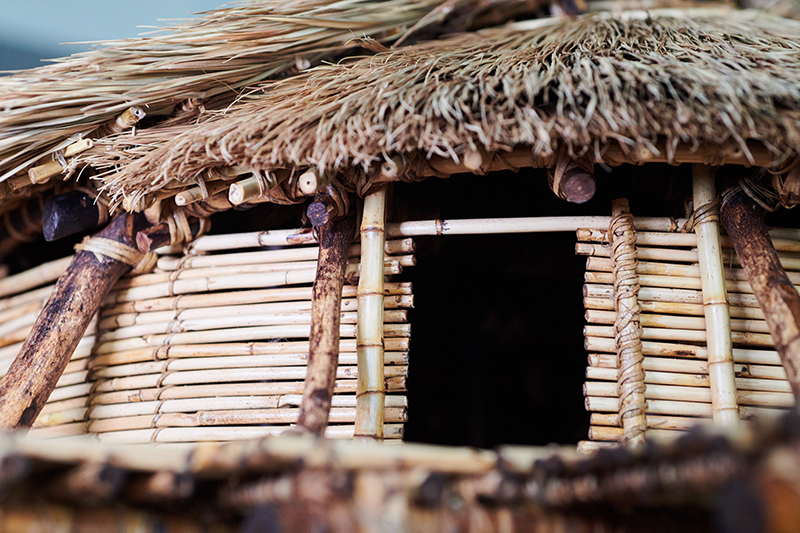
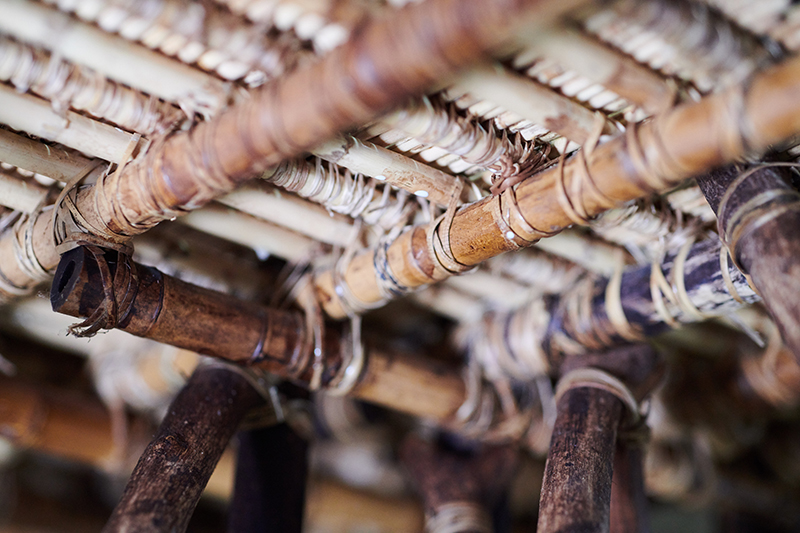

Andoulan’s unwavering dedication to preserve and represent traditional architecture can be found in the miniature house’s pulled doors, knots, and supporting main structure. He does not overlook any step or detail.
Reconstructing the Takuvakuvan
Including All Details Inside
After completing the family house, Andoulan spent another two years collecting information and started his second miniature house in 2017. This time he recreated the Pinuyumayan Takuvakuvan (youth training hall/youth association) which is pretty much non-existent nowadays. Traditional Pinuyumayan culture has strict coming-of-age training rituals for boys. Boys under 12 will enter the Takuvakuvan to train their courage and fighting skills, then they graduate to Palakuwan for further training until they reach adulthood and establish their own family.
The imposing Takuvakuvan is a stilt house built with many interlocked round logs or thick bamboo sticks. The elevated structure protects the young boys from wild animal and enemy attacks. The circular main house is surrounded with bamboo fences and covered with umbrella-shaped beard-grass roofs.
The miniature Takuvakuvan is 110 cm tall and wide. Andoulan not only took care of the details on the building’s exterior, but also meticulously recreated the original interior as well. If you look up from the small bamboo staircase, you will surprisingly find a fence set at the entrance to prevent children from falling. Along the wall there are several long benches. There is even a mini roasting rack over the fire in the house for people to roast their meat or food.
To make it as realistic as possible, Andoulan carefully attended to the tiniest detail. Look closely and you will find scorch marks on the firewood which were made by actually burning the wood. The wooden structure shows a worn-out sheen which is artificially dyed with coloring agent. “The more I wanted to make it as realistic as possible, the more I felt invested in it!” Andoulan happily explained.
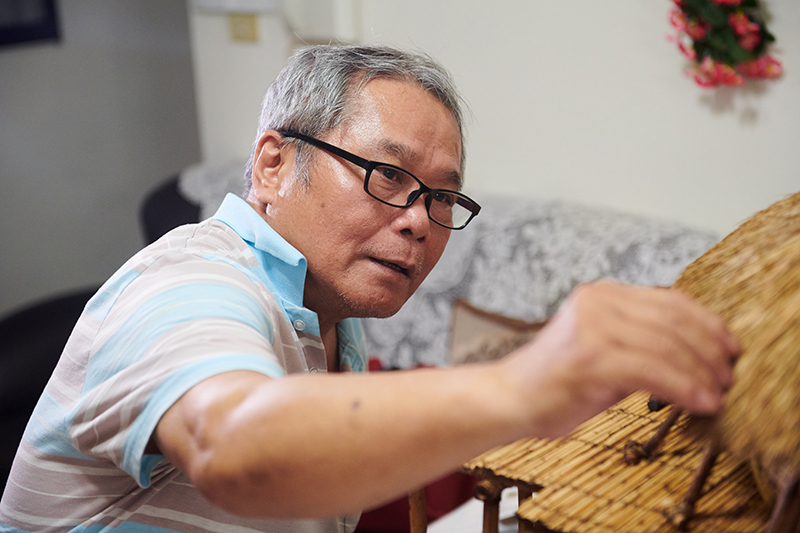
Whenever he has free time, Andoulan stays at home to work on his miniature houses. He plans to submit his soon-to-be completed Takuvakuvan to the competitions and introduce indigenous architecture culture to more people.
Carrying Tools with Him Wherever He Goes
Always Looking for Useful Materials
Because the Pinuyumayan assimilated into the Non-indigenous society relatively early, their traditional architecture has almost all disappeared, and elders who know how to build them are also few and far between. Andoulan had to spend many years doing research and slowly taught himself the relevant knowledge. He found that the most effective way to learn is to visit the locations and observe village buildings and structures.
Tagging along interview assignments, Andoulan visited hundreds of villages around Taiwan in the past eight years. At every village, he would carefully study the buildings’ structures and features, document them with photos, and ask the local elders questions. Traditional architecture that are disappearing, such as the Tsou people's beard-grass assembly hall “Kuba” and the Atayal's semisunken residences, are all invaluable treasures to Andoulan. “Although they are not Pinuyumayan architecture, but we share a lot of similar construction methods that I can borrow.” In addition to site visits, Andoulan also studies books, documents, and old photos. His computer and smart phone are filled with data and reference material, and his smart phone’s home screen is a black and white photo of a Takuvakuvan.
Finding and using the right materials is key when Andoulan begins his construction process. Traditional Pinuyumayan architecture uses wood for beams and columns, bamboo for pilasters, and the roofs are made with beard-grass. Andoulan always leaves his house with a short knife and saw. Whenever he sees wood or bamboo material he may need, he would cut some down for future use. Sometimes he would go down to the riverbed to collect small pebbles. “No matter what I'm making, I always think about the material first,” said Andoulan, “and I'm always collecting them!”
When selecting materials, Andoulan considers their toughness, hardness, and durability and replaces them if needed. For example, traditional Pinuyumayan architecture uses tropical crepe myrtle in their buildings, but the wood may attract termites. In the past, homeowners would build a fire inside the house to smoke away pests and keep the house dry. But since you cannot build a fire inside a miniature house, Andoulan used common jasminorage, which is not appealing to termites, instead.
After the materials are collected, the next step is to dry them in the shade so they can last for a long time. Wood and bamboo need two to three months, and beard-grass would require up to six months –this is the main reason why miniature houses take so long to make.
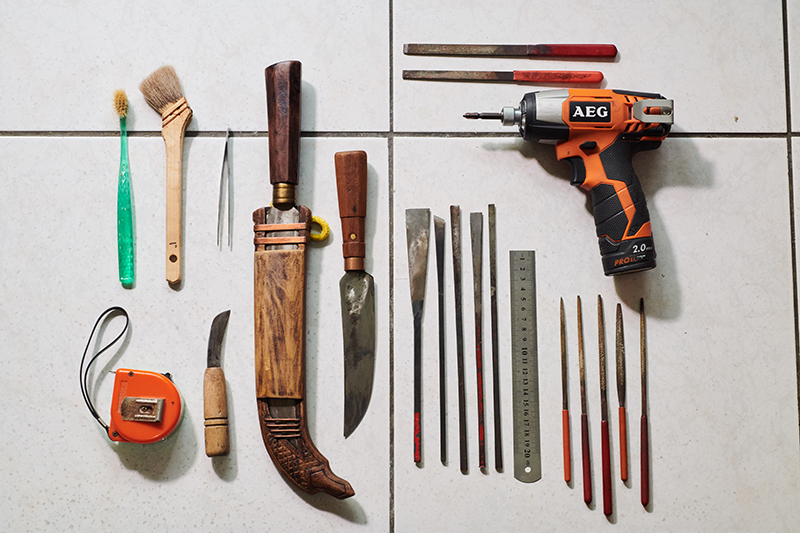
While he was figuring out the miniature house-making process, Andoulan created suitable tools along the way. He even made the short knife handle himself.。
Devoted to Studying and Restoring
Traditional Construction Methods
Andoulan is dedicated to learning any construction method or skill needed to build his miniature house. For example, he had no idea how to shave off the surface layer of vines and weave them, so he diligently practiced for two months. In the end he should shave a strip of vine that is 2 cm thick into a thin string which is only 1.5 mm wide. “If you are interested in it, you will want to perfect it.” Andoulan explained as he pointed to his vine string. Assembling the main structure is the most important step in making miniature houses, and the vine string knot must be knotted very tight or else the house would topple and collapse.
After explaining the process of building the main structure, Andoulan moved on to the key points in creating dirt walls. “You have to mix grass bits into the mud, then fill in the cracks in the wall. This is to ensure that if the mud dries and cracks off, it will not fall off directly, because the grass fibers will still support it.” And the step of filling in the cracks cannot be completed in one go. Andoulan repeated the process three times to achieve the smoothness and thickness he wanted.
He remembered when he was seven or eight years old, his relatives and friends were building their large family houses. Back then they mixed cow dung, which also had a lot of fibers, with the mud. Andoulan laughed and said, “I helped stomp the mud!” Although there are no more traditional houses in the village now, Andoulan still managed to recreate the building methods of family houses from memory.
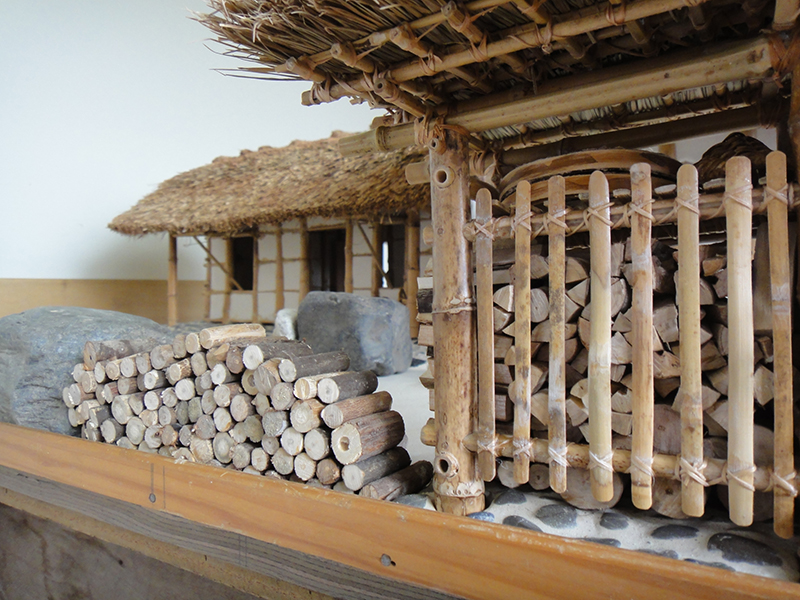
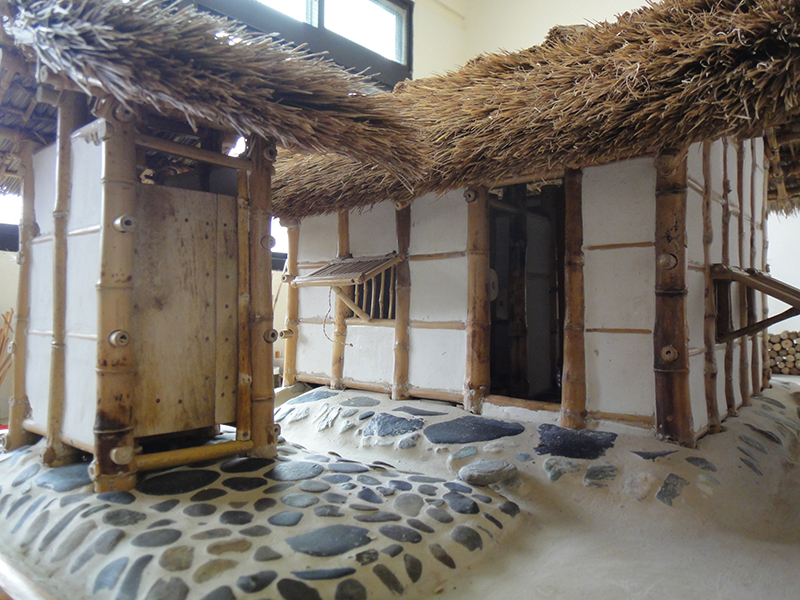
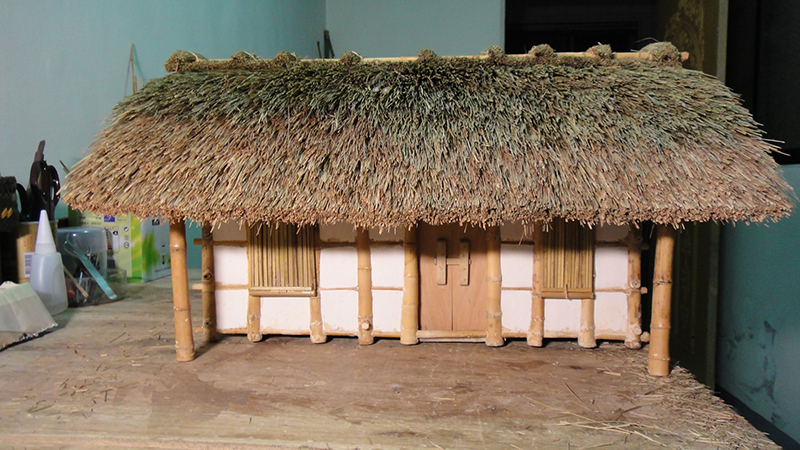
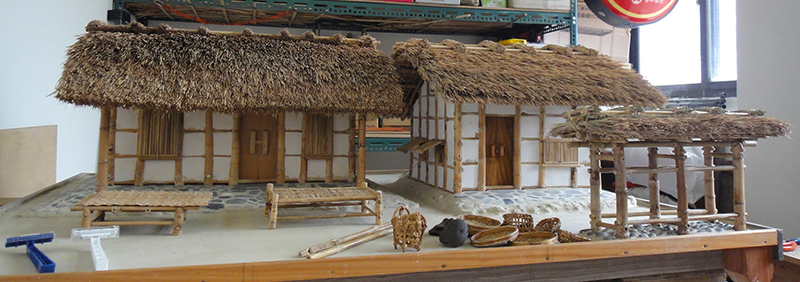

The Pinuyumayan family house is Andoulan's first piece of work. The materials and exterior are all selected and built according to traditional construction methods. Viewers can enjoy the miniature house and imagine how the Pinuyumayan ancestors lived in it.
Not Just Making Models
But Also Reconstructing Pinuyumayan Architecture
Because there are no actual houses to refer to, Andoulan often had to redo certain steps because the ratio was not right. For example, if the bamboo clums were too long for the house, he had to take them down one by one and cut them shorter. The five layers of grass roofs on the Takuvakuvan cannot be woven too tight or too thick, so he spent six months just to tie the grass perfectly.
Andoulan is completely dedicated to making miniature houses. If he has a day off, he would spend the entire day at home constructing them. In addition to Pinuyumayan architecture, Andoulan already has plans to make six more miniature houses, including an Atayal semi-sunken residence, an Orchid Island underground house, and a Tsou Kuba. After he retires from his day job, Andoulan plans to go back to his village and build an actual Takuvakuvan for the public to visit. “I’ll invite young community members to help me build it. I want to pass on the traditions.” Said Andoulan. He also plans to hold a small exhibition in the community after the six miniature houses are completed so that more people can see and experience the beauty of indigenous architecture.




